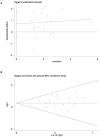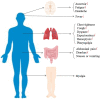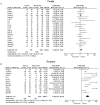Clinical Symptom Differences Between Mild and Severe COVID-19 Patients in China: A Meta-Analysis
- PMID: 33520906
- PMCID: PMC7841395
- DOI: 10.3389/fpubh.2020.561264
Clinical Symptom Differences Between Mild and Severe COVID-19 Patients in China: A Meta-Analysis
Abstract
Objective: The prognosis of mild and severe patients has prominent differences during the prevalence of COVID-19, and it will be significant to identify patients' potential risk of progressing to severe cases according to their first clinical presentations. Therefore, we aim to review the clinical symptoms of the COVID-19 epidemic systematically. Methods:We searched PubMed, Embase, Web of Science, and CNKI (Chinese Database) for studies about the clinical features of COVID-19 in China from March 18 to April 18. Then we used REVMAN to conduct a meta-analysis. Results: After screening, 20 articles including 3,326 COVID-19 confirmed cases were selected from 142 articles we retrieved at the beginning of our research. We divided all the cases into a severe group (including severe and critically severe patients) and a mild group according to the "Diagnosis and Treatment Protocol for Novel Coronavirus Infection-Induced Pneumonia" version 4 (trial). Of all the initial symptoms (including fever, cough, abdominal pain, anorexia, chest tightness, diarrhea, dyspnea, expectoration, fatigue, headache, hemoptysis, myalgia, nausea or vomiting, and pharyngalgia) we studied, we found that cough (odds ratio [OR] = 1.4, 95% confidence interval [CI]: 1.2-1.7; p < 0.001), fever (OR = 1.5, 95% CI: 1.2-1.9; p < 0.001), dyspnea (OR = 6.2, 95% CI: 3.6-10.6; p < 0.001), diarrhea (OR = 2.6, 95% CI: 1.3-4.9; p < 0.001), fatigue (OR = 2.1, 95% CI: 1.3-3.3; p < 0.01), expectoration (OR = 1.7, 95% CI: 1.2-2.6; p < 0.01), myalgia (OR = 1.6, 95% CI: 0.8-3.1; p < 0.001), hemoptysis (OR = 4.0, 95% CI: 1.5-11.3; p < 0.001), abdominal pain (OR = 7.5, 95% CI: 2.4-23.4; p < 0.001), and anorexia (OR = 2.8, 95% CI: 1.5-5.1; p < 0.001) had a different distribution in two groups and were statistically significant (p < 0.05). Conclusion:COVID-19 patients whose initial manifestation is dyspnea, hemoptysis, anorexia, diarrhea, or fatigue, especially abdominal pain should be closely monitored to prevent disease deterioration.
Keywords: COVID-19; clinical features; differences; meta-analysis; risk factor.
Copyright © 2021 He, Cheng, Feng, Wan, Chen and Xiong.
Conflict of interest statement
The authors declare that the research was conducted in the absence of any commercial or financial relationships that could be construed as a potential conflict of interest.
Figures








References
Publication types
MeSH terms
LinkOut - more resources
Full Text Sources
Other Literature Sources
Medical
Miscellaneous

